Bark is the outer covering of a tree’s trunk and branches. Bark is analogous to an animal’s skin. Its purposes are conserving water and protecting the tree’s essential living systems from temperature extremes and storms as well as from attacks by diseases, animals and insects. Some tree species have extra-thick bark that protects the tree from brush fires. Bark also transports food and water throughout the tree. Severe bark damage will kill the tree.
Trees with stunning white or chalky bark create bright contrast against their foliage and surrounding environment. These trees are less common than trees with dark bark. Trees with white bark include:
- Sycamore
- White Poplar
- Quaking Aspen
- Ghost Gum
- River Birch
- Himalayan birch
- Paper bark birch
- Japanese white birch
- Snakebark Maple
- Whitebark pine
- White Satin Birch
- Erman’s Birch
- Palo Blanco Tree
- Brazilian Ironwood Tree
- White Alder Tree
Sycamore
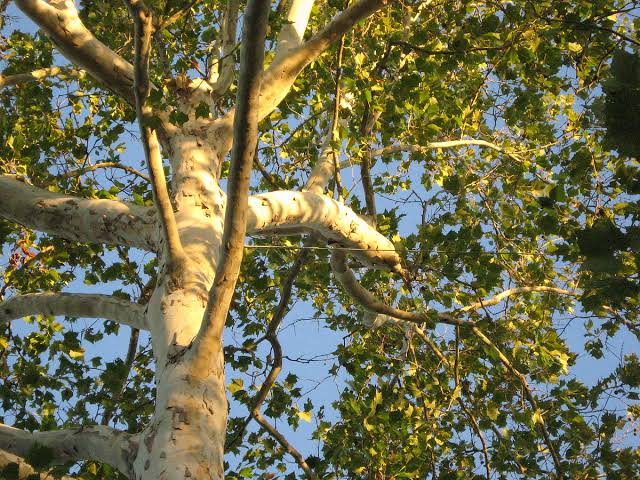
Most Sycamore are large, majestic trees with spreading canopies, large lobed deciduous leaves, and white bark peeling to reveal darker patches.The main trunk of sycamores typically split into two to four large branches that support spreading foliage with a symmetrical shape that can reach 50 to 70 feet in width and 75 to 90 feet in height.
Sycamores adapt well to any soil type to grow into large, beautiful trees that provide excellent shade. This deciduous tree loses its leaves in the winter and produces seedpods that hang in clusters of three or more from each limb. Because they grow fast, tolerate different and are long-lived, American sycamores are used for streets, parks, reclamation projects and home landscaping.
White Poplar
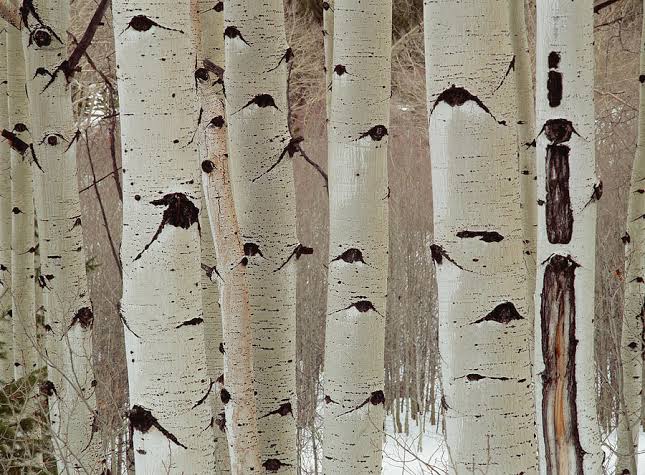
The white poplar tree is a fast-growing, deciduous tree that can reach a height of 100 feet at maturity. It spreads to cover an area of about 50 feet and provides dense shade. The tree’s dark green leaves have fuzzy, whitish undersides, giving a sparkling effect when breezes blow. Its yellow flowers are tiny and inconspicuous, and appear in spring, after which small seedpods containing many seeds follow. It’s bark is smooth and white, and becomes a bit rough and ridged on an older tree.
White poplars have a single upright trunk that produces many smaller branches with an upright form. White poplars grow best with full exposure to sunlight and have a high tolerance to dry growing conditions. The wood of this tree is brittle and can break under high winds, making it unsuitable for use near buildings.
Also Read: Trees With Beautiful Fall Color
Trembling Aspen

Trembling aspen trees reach up to 65 feet tall in ideal growing conditions. Aspen tree bark is creamy white with dark brown or light gray markings. As trembling aspens age the bark becomes darker and often develop thick ridges. In the spring, tiny flowers cluster together forming silvery catkins, which appear before the leaves unfurl. The round to oval leaves grow in light green, then turn bright gold in autumn. Greenish white fruit capsules less than 1/2 inch long appear during the summer.
Trembling aspen trees are commonly planted in landscapes to produce a quick forest-like feel. Clustering the trees together maximizes the impact of the brilliant autumn color of the leaves. These aspen trees work well to block undesirable summer views and city noise.
Ghost gum
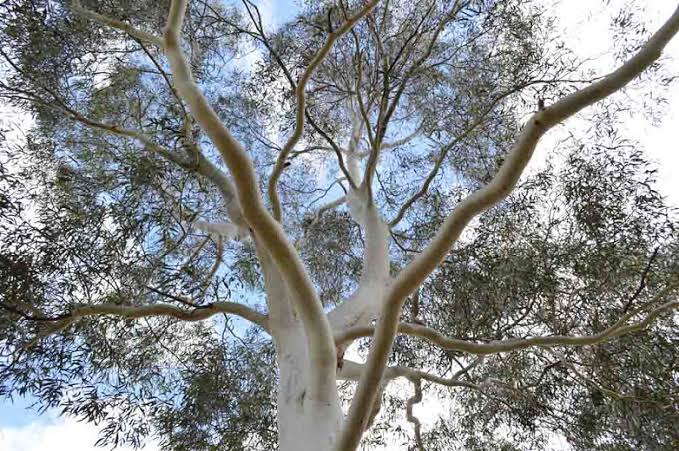
Ghost gum trees have a tall, slender shape with a rounded top and slightly pendulous, draping branches. The spear-shaped leaves are silver or grayish-green in color and hang like garlands from the branches. The foliage develops a soft purple tinge when exposed to frost. In summer, ghost gum trees produce masses of very small white flowers that later develop into woody, bell-shaped nuts, which add ornamental value.
Ghost gums typically grow between 40 and 60 feet in height with narrow foliage that reaches 20 to 25 feet in width. Other than the growth habit, the most significant characteristic of the ghost gum tree is its ghostly white bark.The smooth, pale bark reveals the tree’s open, spreading branch structure. Ghost gum trees grow best when planted in a sunny or lightly shaded bed with fast-draining soil.
River Birch
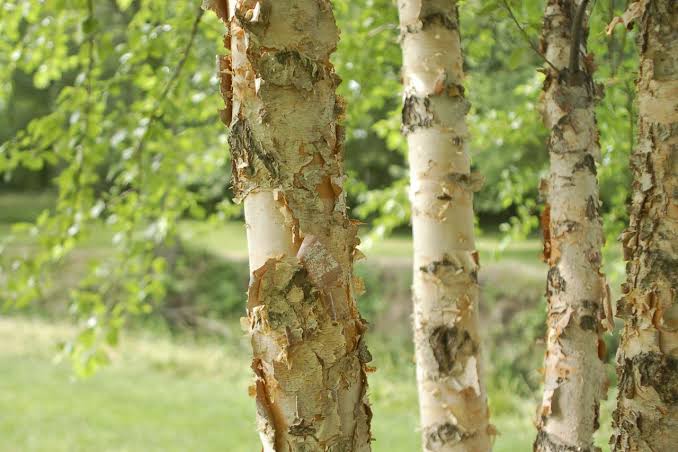
River birch, also known as red birch, black birch or water birch, is native to the southeastern United States where the trees typically grow in thickets along rivers and lakeshores, as well as on floodplains, sandbars and islands in streams. Without pruning, it grows with several trunks.
River birch is a fast-growing tree that reaches between 50 and 90 feet in height. Its diamond shaped, double-toothed leaves produce an erect or spreading canopy that covers an extensive area. The leaves turn yellow in the fall. When young, its peeling bark is silvery gray, before changing to pink, reddish-brown or black when mature. It produces flowers in the spring and winter, and small brown or green cones in the summer.
Himalayan Birch
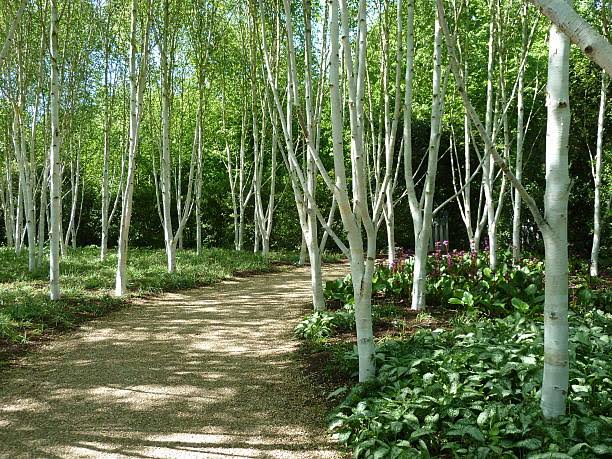
Himalayan Birch has a pyramidal shape, with branches that extend upward and open. Yellowish-brown male flowers in 3-5 inch drooping catkins appear in the spring. Greenish female blooms create smaller upright catkins, followed by drooping fruits that contain small, winged seeds in early autumn. Leaves resemble slightly rounded ovate wedges, 2 to 3 inches wide.
Himalayan birch is easily recognisable by its dazzlingly white, silky smooth bark. As with other birches, as it grows, the old bark peels away revealing the new bark underneath, creating pleasing stripes on the trunk.The vivid trunks make this an ideal candidate to be planted in groups of three or as a multi-stemmed specimen, offering wonderful winter interest when the leaves have fallen.
Paper Birch
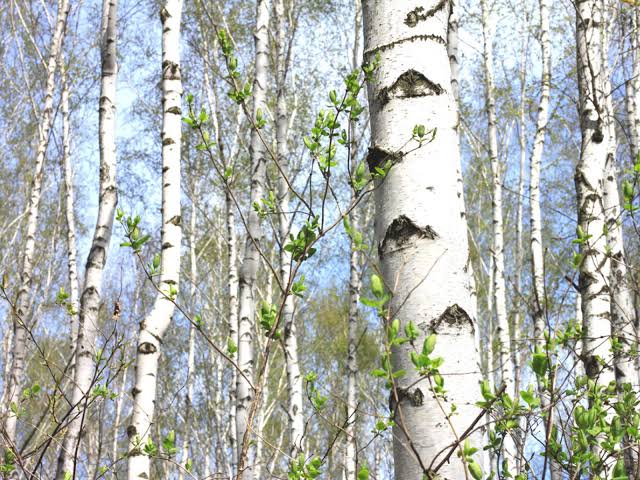
The paper birch tree is a fast-growing but short-lived tree that often develops multiple trunks as the plant matures. The most distinctive characteristic of this deciduous tree is the peeling bark, which contrasts sharply against the green leaves that turn bright yellow in fall. The peeling white bark blends well with winter’s snowy surroundings.
Paper birch grows well in areas where it doesn’t get too hot, such as northern California. It needs plenty of sun but it also requires very moist soil; use mulch when planting to help keep the ground moist around the paper birch tree’s shallow root system.
Japanese White Birch
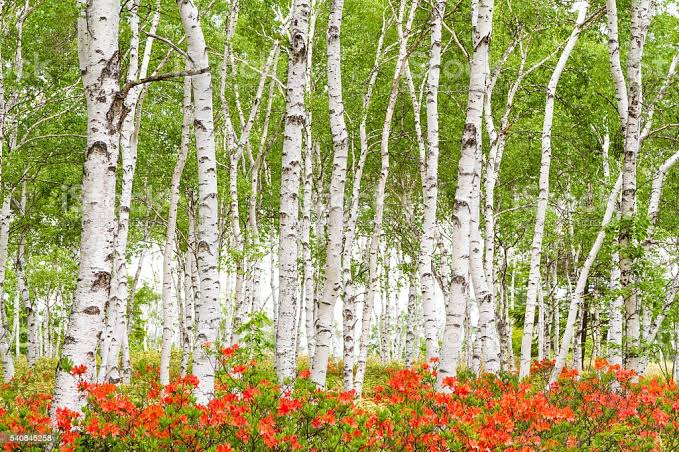
Japanese white birch, also known as Asian white birch, is a medium to large size tree that typically reaches about 30-40 feet at maturity with a rounded or columnar form.The leaves are alternately arranged, simple, ovate in shape, glabrous, and have toothed margins. They are yellowish-green in color with no notable fall color.
The Japanese White Birch Tree stands out dramatically in the landscape due to its contrasting magnificent white colored bark. The tree prefers full sun to partial shade, and medium to wet, well-drained, loamy, sandy, or clay soils. It grows best in cool climates and consistently moist soil.The drought tolerance of Japanese white birch is poor.
Also Read: Flowering Trees For Landscaping
Snakebark Maples

Snakebark maples are upright, often multi-trunked tree with arching branches. Smooth, olive green bark is streaked with green and white. Leaves are ovate and unlobed growing in an opposite leaf arrangement. Leaves are dark green and have doubly serrate margins. Small, yellowish flowers bloom in pendant racemes that are 2″ to 3″ long in the spring.
Snakebark Maple is an open deciduous tree with a shapely oval form. Its average texture blends into the landscape, but can be balanced by one or two finer or coarser trees or shrubs for an effective composition.
Whitebark Pine

Whitebark pine also referred to as subalpine is a tree that varies in shape from a small tree with a rapidly spreading trunk and broad crown to a shrub with a wide-spreading crown and twisted, gnarled branches when exposed to strong winds. It is similar in appearance to limber pine, but its cones are quite different.
Whitebark pine prefers to grow on dry to moderately moist sites in subalpine areas. Needles-like leaves occur in bunches of five, ranging from 3 to 9 centimetres long; they are stiff, slightly curved, usually bluish-green, and tend to be clumped towards the ends of branches. It’s bark is thin, smooth, and chalky-white on young stems; as the tree gets older, the bark becomes thicker and forms narrow, brown, scaly plates.
White Satin Birch
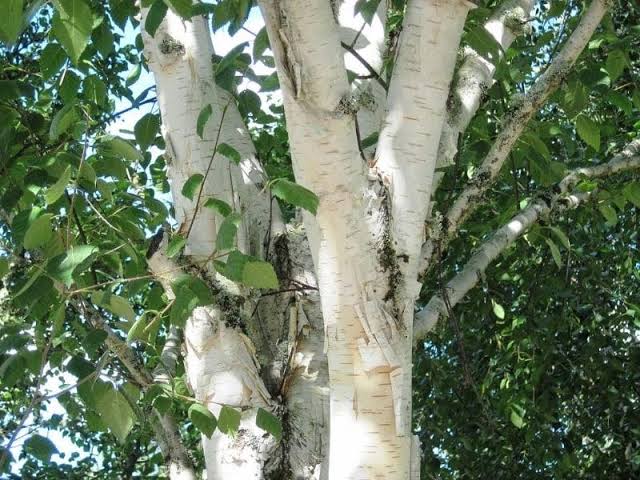
White satin birch is valued for its stunning white bark, with tan and pinkish colors peeling from mature trunks. White Satin Birch has dark green foliage throughout the season. The pointy leaves turn an outstanding yellow in the fall. Neither the flowers nor the fruit are ornamentally significant. The peeling white bark is extremely showy and adds significant winter interest.
White Satin Birch will grow to be about 35 feet tall at maturity, with a spread of 20 feet. It has a low canopy with a typical clearance of 3 feet from the ground, and should not be planted underneath power lines. It grows at a fast rate, and under ideal conditions can be expected to live for 70 years or more.
Erman’s Birch

Erman’s Birch is a graceful, vigorous tree renowned for its creamy-white and pinkish bark, attractive in all seasons but taking centre stage in winter, particularly when set amongst dark evergreens.The summer foliage of Erman’s birch is bright green, often heart-shaped, with conspicuously veined leaves, giving golden autumn tones.
Palo Blanco
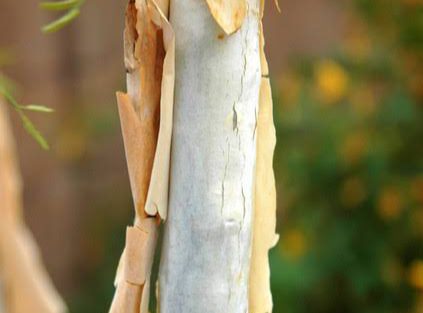
Palo blanco (white stick) is a small to medium size deciduous tree with an upright habit and open branching character that can grow 15-25 ft. tall and 10-15 ft. wide. Creamy-white flower spikes occur in late spring, occasionally throughout the year, and are followed by flattened seed pods to 4-6 in. long.
The foliage of the tree consists of long weeping phyllodes with small pinnately compound leaves. The phyllodes can be over a foot long and turn an orange color and are shed throughout fall and winter and spring until new foliage begins to grow. The white trunk also stands out handsomely when planted adjacent to colorful walls.
Brazilian Ironwood
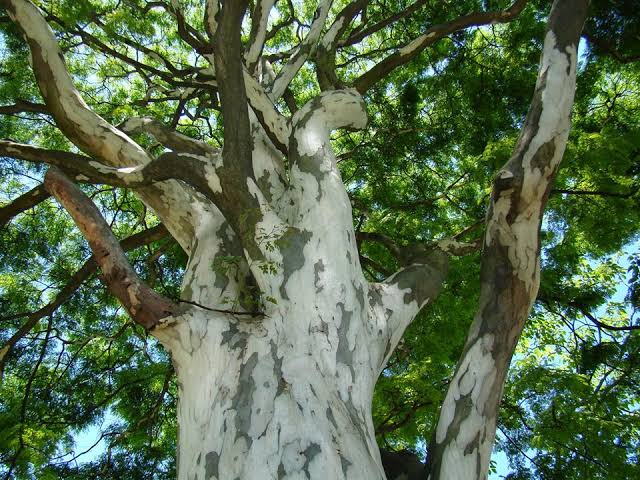
The Brazilian Ironwood is a handsome tree which can grow to 20 feet tall with a fluted-base and a rather flat-topped crown. The species originates from tropical America including Brazil and Bolivia and is popularly planted in Singapore for its ornamental characteristics.
Although it is an understory tree in its native environment, an ironwood tree performs well in sunny, cultivated landscapes, where it grows 20 to 30 feet tall and wide. It also grows well alongside lakes and streams and tolerates wet soils and flooding.
The trunk is light buff-white, smooth to touch and rather like soft leather. With age, the bark becomes grey or brownish and peels off in long, jagged and curled pieces, leaving spots of beige new bark. The multi-hued trunk resembles the colouration of a leopard’s hide, giving rise to its other common name, Leopard Tree.
White Alders
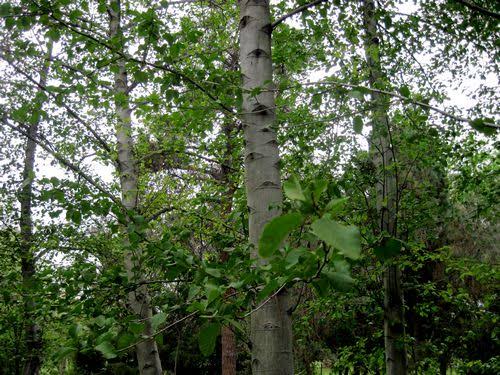
White Alders are wonderful trees, fast-growing, lush trees needing lots of sunlight and water. They’re prettily formed, so dense that they produce a chilly shade, and even their leaves are somewhat fragrant if you bruise them. It is a medium-sized deciduous tree growing to 15-25 meters (rarely to 35 meters) tall, with white or pale gray bark, smooth on young trees, becoming scaly on old trees.
The flowers are produced in catkins. The male catkins are pendulous, slender, 3-10 centimeter long, yellowish, and produced in clusters of two to seven; pollination is in early spring, before the leaves emerge. The tree produces very large amounts of pollen at this time.
Further References
- Trees With White Bark: https://www.bobvila.com/articles/trees-with-white-bark/
- Beautiful Trees With White Bark: https://www.fast-growing-trees.com/pages/white-bark-trees
- White bark trees: https://homeguides.sfgate.com/kinds-trees-white-bark-70243.html